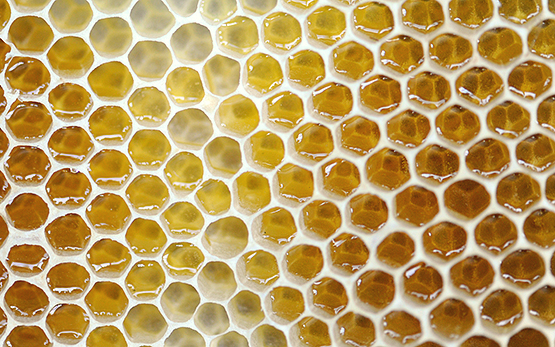Der Wassergehalt des von den Pflanzen produzierten Nektars kann variieren. Um seine Konservierung in den Waben zu gewährleisten, darf er nicht gären. Deshalb wird er von den Bienen in Honig umgewandelt, indem sie seinen Wassergehalt senken und folglich den Zuckergehalt erhöhen. Dies verhindert die Entwicklung der Mikroorganismen. In der Dunkelheit des Bienenstocks ist es schwierig, den Herstellungsprozess des Honigs zu beobachten. Aus diesem Grund ist er auch nur wenig erforscht. Um die Umwandlung von Nektar in Honig zu untersuchen, haben wir die Technik der Tomographie eingesetzt. Sie ermöglicht es, den Zuckergehalt des eingelagerten Nektars sehr präzise zu messen, ohne den Bienenstock öffnen zu müssen und das Bienenvolk zu stören.

Pubblicazioni Ivan Hiltpold
Kehrli P., Grabenweger G., Weibel J., Collatz J., Egger B., Guyer A., Sann C., Sutter L., Horrocks K., Hiltpold I., Boss M., Gaume A., Carlen C., Mazzi D.
Il coleottero giapponese (Popillia japonica), un organismo di quarantena invasivo: Biologia, diffusione, potenziale nocivo e misure di sorveglianza e di lotta.
Agroscope Transfer, 581, 2025, 1-65.
altre lingue:
Breitenmoser S., Hiltpold I.
Les ravageurs sont surveillés de près.
Journal Agri, 21 février, 2025, 18.
Brabant C., Kellenberger S., Demal S., Steinger T., Hiltpold I.
Wirkungen der Begleitpflanzen auf den Vektor der virösen Vergilbung von Zuckerrüben (Myzus persicae).
In: 12ème Journée Nationale en grandes cultures. 17. Januar, Ed. Agroscope, Bienne (CH). 2025.
Brabant C., Kellenberger S., Demal S., Steinger T., Hiltpold I.
Effets des plantes compagnes sur Myzus persicae, vecteur des jaunisses virales de la betterave.
In: Journée phytosanitaire en grandes cultures. 17 janvier, Ed. Agroscope / Agridea, Bienne (CH). 2025.
Lewis E. E., Stevens G., Hiltpold I., Shapiro-Ilan D.
Behavioral ecology of entomopathogenic nematodes.
In: Entomopathogenic Nematodes as Biological Control Agents. Ed. CAB International (CABI), Oxfordshire (UK). 2024, 112-125.
Moisan K., Kostenko O., Galeano M., Soler R., van der Ent S., Hiltpold I.
Successful foliar application of Steinernema spp. EPNs to control Lepidopteran caterpillars.
In: 19th Annual Biocontrol Industry Meeting. 21 October, Ed. ABIM AG, Basel (CH). 2024.
Hiltpold I.
Viability of entomopathogenic nematodes in insect pest management: A chemical ecology perspective.
In: XXVII International Congress of Entomology. 30 August, Kyoto (JP). 2024.
Magnin L., Thaize R., Hiltpold I., Laurent E.-A., Jullien A., Baux A.
Évaluation de la tolérance et de l’antixénose variétale du colza face aux attaques de sa cohorte de ravageurs.
In: 13ème Conférence internationale sur les ravageurs et auxiliaires en agriculture (CIRAA). 30 octobre, Ed. Végéphyl, Montpellier (FR). 2024.
Baux A., Magnin L., Laurent E.-A., Breitenmoser S., Hiltpold I.
Wie tolerant sind welche Rapssorten?
Revue UFA, 7, (8), 2024, 16-19.
Baux A., Magnin L., Laurent E.-A., Breitenmoser S., Hiltpold I.
Moins de dégâts dus aux ravageurs grâce au choix variétal.
Revue UFA, 7, (8), 2024, 16-19.
Breitenmoser S., Hiltpold I.
Synthèse et bilan du Réseau pyrale du maïs 2024.
Agroscope. 2024, 22 pp.
Magnin L., Thaize R., Grand A., Laurent E.-A., Nussbaum V., Breitenmoser S., Hiltpold I., Baux A.
Evaluation de l’attractivité variétale sur la cohorte de ravageurs du colza.
In: Journée des Grandes Cultures Bio. 26-27 juin, Ed. FiBL, Aubonne. 2024.
Hiltpold I., Rasmann S., Ali J. G.
Chemical ecology of entomopathogenic nematodes: Back to the future.
In: 56th Annual Meeting of the Society for Invertebrate Pathology. 29 July, Vienna. 2024, 1-20.
Sion A., Hiltpold I., Verheggen F., La Forgia D.
Odour hunters: Deciphering the impact of egg-emitted VOCs on host recognition in Trissolcus basalis and T. japonicus (Hymenoptera: Scelionidae).
In: 39th Annual Meeting of the International Society of Chemical Ecology (ISCE). 14 July, Prague. 2024, 1-27.
Moisan K., Kostenko O., Galeano M., Soler R., van der Ent S., Hiltpold I.
The sky is not the limit: Successful foliar application of Steinernema spp. entomopathogenic nematodes to control Lepidopteran caterpillars.
Journal of Invertebrate Pathology, 206, 2024, 1-11.
La Forgia D., Gindro K., Hiltpold I.
Les oeufs de la punaise marbrée, source d'innovations phytosanitaires.
Journal Agri, 15 mars, 2024, 20.
Hiltpold I., Breitenmoser S., Bolis L., Rasmann S., Baux A., Magnin L., Laurent E.-A., Bessat M., Petremand G.
Culture du colza et lutte contre ses insectes ravageurs : La durabilité est-elle possible ?
In: Annual meeting of the Swiss Entomological Society. 8 mars, Neuchâtel. 2024, 1-29.
Hiltpold I.
Better together than alone: The use of intercropping in field crops.
In: Phytomedical Colloquim. 22 November, Goettingen. 2023, 1-37.
Hiltpold I., Soler R., Galeano M., Moisan K.
Sky is not the limit: Successful application of soil-dwelling entomopathogenic nematodes to control Lepidopteran caterpillars on leaves.
In: 55th Annual Meeting of the Society for Invertebrate Pathology. 30. July, Maryland. 2023, 1-13.
La Forgia D., Hiltpold I., Cleroux M., Favaro R., Gindro K.
The killer detects prey’s odours: can fungi be attracted to Halyomorpha halys eggs by their volatiles?
In: European conference of Entomology 2023. 16. October, Heraklion (GR). 2023, 284.






